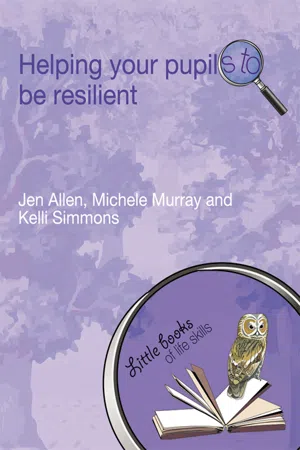![]()
1 What is resilience?
Resilience is the process of developing survival capacities in the face of life’s emotional, social and physical challenges. Repairing from the harms supports the individual to face future life adversities with greater strength.
A person can display resilience by reaching out, standing u p and walking on when they have encountered one of life’s pitfalls. Next time, perhaps, the individual will be able to identify ‘the hole’ earlier and approach it differently.
The strength of an individual’s resilience depends on their beliefs, skills and supports. This is developed from their life experiences and determines their protective capacity to respond resiliently. Learning to be resilient builds upon a person’s self-esteem and optimism.
Today’s pupils will move through multiple careers in their lifetime. Many will live in communities without knowing their neighbours and will not have the support of extended family. Hence, the development of young people’s resilience is more important than ever, to manage the rate of change, unpredictability and increased isolation in our communities.
The good news is that individuals have an innate capacity to develop resilience. Resilience is not a fixed state but an emerging state. However, life is unpredictable and each individual is neither always resilient nor non-resilient. Responses to adversity will depend upon the number of stressors and their coping mechanisms, formed by beliefs, skills and supports.
Within a school environment, teachers and the whole school community can have a positive, life-sustaining impact upon pupils. Teachers must ensure that they nourish and develop their own protective capacity to be resilient. This is one of the primary steps towards a systemic approach to building resilient school communities.
Consequently, teachers can promote resilience through their language, actions and the surroundings they help to create. They can plan for and teach pupils to be more self-sufficient, independent, responsible, considerate and selfless, and to approach people and situations with optimism. In addition, they can explicitly teach pupils how to communicate with others, problem solve and successfully handle pessimistic thoughts, feelings and behaviours.
In an effective whole school community, pupils become active and self-managing in the promotion of their own resilience.
The resilient recovery process
Resilience is not an end state but rather a collection of protective attributes that support an individual during the process of facing one of life’s adversities. The individual is guided to become more resilient in an effective whole school community context that delivers supportive structures and strategies.
The diagram opposite shows the process of a pupil’s resilient recovery from an adverse event.
What is an adverse event that a pupil may face?
There are a number of adversities that can affect a pupil’s performance–emotional, physical or social. Possible adversities that may challenge a pupil’s resilience during a school day include:
■ Bullying
■ Changing school
■ Cultural conflict
■ Family problems
■ Learning difficulties
■ Missing out on team selection
■ Physical differences of the pupil
■ Stolen or damaged property
■ Friendship difficulties
■ A feeling of not belonging
A pupil may face a compounding number of these adverse events at any given time, possibly resulting in them becoming more vulnerable and requiring greater support. For example, if the pupil who did not receive the party invitation also has parents who divorced during their early developmental years, feelings of abandonment may be triggered, intensifying the initial response. In this case, the early intervention strategy of counselling may be suggested by the school.
What are the individual’s sources of resilience?
There are three vital sources of a pupil’s understanding of self, which support their developing resilience: beliefs, skills and supports. Resilience results from a combination of these sources.
The pupil’s perception of their beliefs, skills and supports forms protective understandings. This has as much impact upon their capacity to cope as the reality of their beliefs, skills and supports. For example, if a pupil perceives that they can’t turn to their parents for support, then even if supportive parents really exist, their response will be as if the support is not there at all. The task of the teacher in this case will be to make the sources of support explicit to the pupil.
In order for a pupil to be resilient they need to develop protective understandings across beliefs, skills and supports. A resilient pupil does not need all of these beliefs, skills and supports to be resilient, but one is not enough. The table opposite demonstrates examples of this.
We honour the professional and parental wisdom, along with the sustained personal efforts, that many teachers and parents commit to daily. However, it is an unfortunate truth that some pupils’ experiences crush or impede resilience as they receive mixed messages. They feel helpless, sad and not fully supported within the whole school community. This is not necessarily the intention; it is more the fact that some people are not clear about resilience or how to promote it in children.
Sources of resilience
Within the school environment the classroom teacher can make the interconnections between the pupil, family and wider community explicit. The classroom teacher’s ability to have a sustaining impact ideally requires a whole school systemic approach. They cannot do it alone. Just as the children need adults who know how to promote resilience and are, indeed, becoming more resilient themselves, so too the teacher needs the support of the school. However, do not underestimate the powerful lifelong influence of a teacher who truly understands and attends to the individual’s emotional and social needs.
It is important to note that the individual cannot be seen in isolation from their environment. In the course of any given day the individual may move between the roles of daughter, pupil, friend, sibling, grandchild, etc. as they shift environment. Therefore, the first step may be building the relationships of a supportive whole school community.
The stronger the communication is between the family and school, the greater the chance for fostering pupils’ protective understandings. This acts collaboratively to promote the growth of re...




